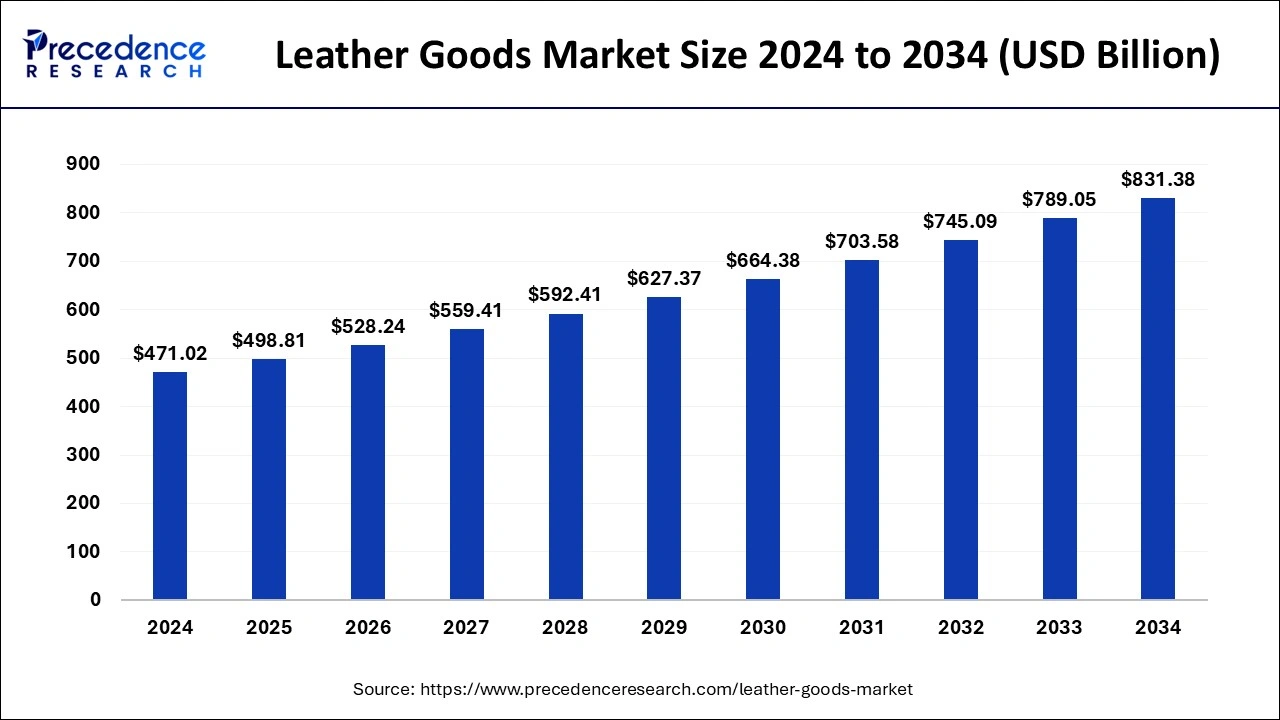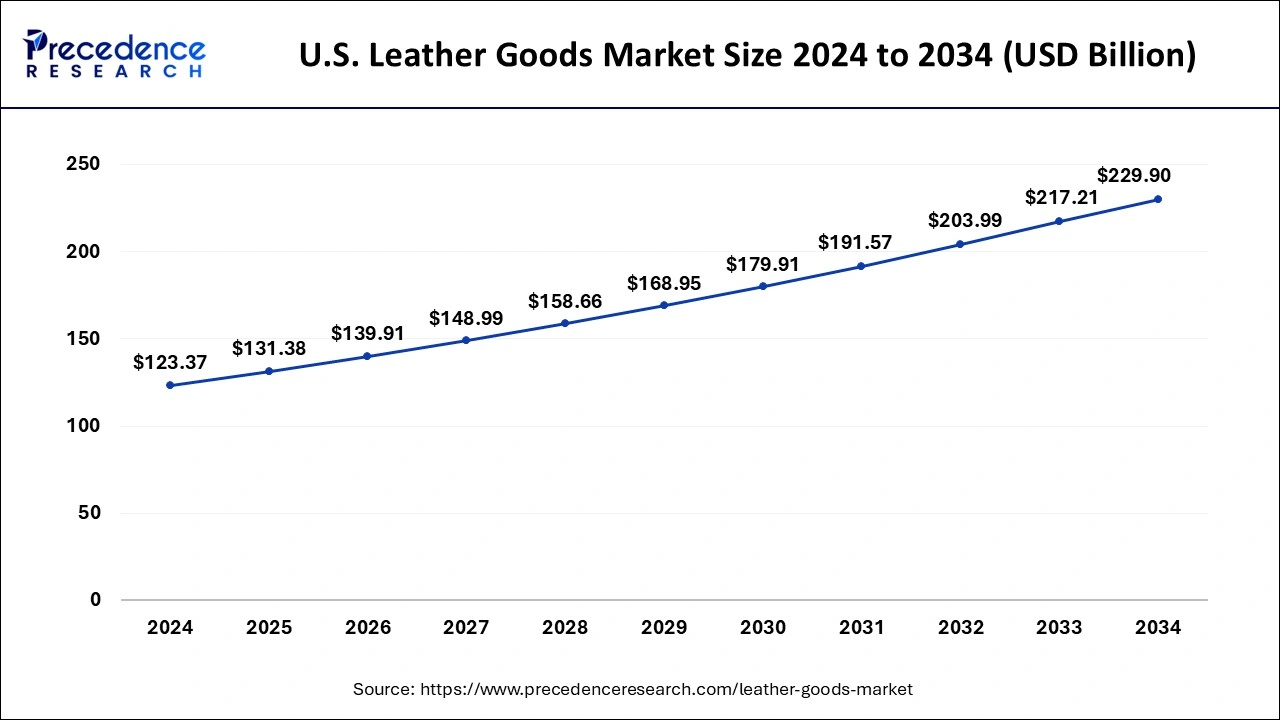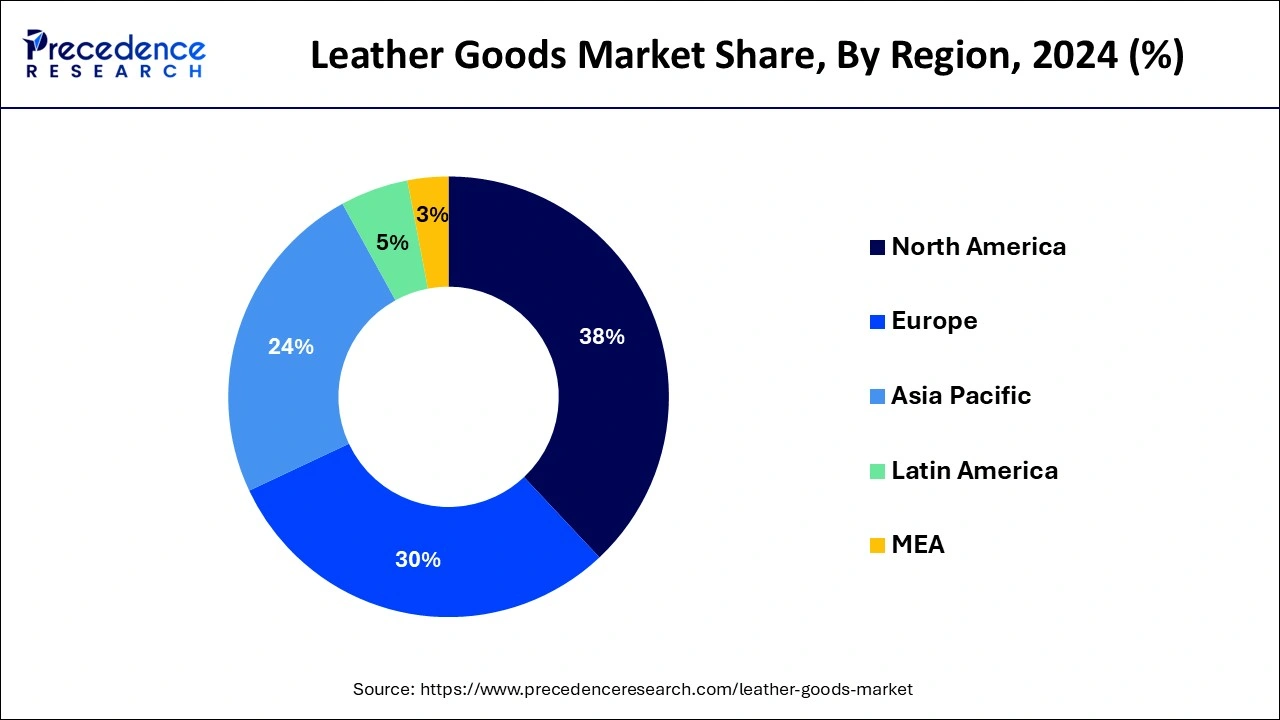The global leather goods market size is calculated at USD 498.81 billion in 2025 and is forecasted to reach around USD 831.38 billion by 2034, accelerating at a CAGR of 5.85% from 2025 to 2034. The North America leather goods market size surpassed USD 178.99 billion in 2024 and is expanding at a CAGR of 5.88% during the forecast period. The market sizing and forecasts are revenue-based (USD Million/Billion), with 2024 as the base year.
The global leather goods market size was accounted for USD 471.02 billion in 2024, and is expected to reach around USD 831.38 billion by 2034, expanding at a CAGR of 5.85% from 2025 to 2034.

Leather is a durable and stretchable material derived from the skin of animals like goats, horses, camels, Buffalo, sheep, cattle, and hogs. It is used in the manufacturing of furniture, clothes, bags, gloves, footwear, watches, harnesses, and other articles, due to its flexibility, durability, and strength. It is scratch-resistant and fire-resistant, which makes it a long-lasting product. It is comfortable and repairable which is preferred in the manufacturing of various articles. The use of leather in apparel and sports equipment has increased in recent times.
The U.S. leather goods market size was estimated at USD 123.37 billion in 2024 and is predicted to be worth around USD 229.90 billion by 2034, at a CAGR of 6.42% from 2025 to 2034.

38% of the market share was held by the North American region in the past and this shall continue in the coming years. Online purchases available for the North American region and other nations of the world will play a significant role in the growth of the market. The popularity of premium leather products has taken the industry by storm. The constantly evolving fashion industry creates more demand for leather. Premium quality bags, shoes, accessories, and other products are purchased on a large scale in the North American and European regions.
High self-esteem is associated with these products due to which the consumption of these products in the high-income groups is more. The consumption of leather goods is maximum in the U.S., Mexico, and Canada.

The fastest growth will be registered in the Asia Pacific nations, especially India and China. Luxury products and premium products have a good demand in the Asia Pacific region. Pakistan and Bangladesh are the major exporters of leather in the Asian region. Fitness-conscious and health-conscious consumers are also expected to fuel market growth in the coming years.
One of the attractive markets in the Asia Pacific region is Bangladesh which has fewer tariff rates for the export of leather goods. In recent times every year, about 15 to 20 manufacturing plants for leather goods were opened in Bangladesh.
Europe is expected to grow at a CAGR of 6.8% over the forecast period.
| Report Coverage | Details |
| Market Size in 2025 | USD 498.81 Billion |
| Market Size by 2034 | USD 831.38 Billion |
| Growth Rate from 2025 to 2034 | CAGR of 5.85% |
| Largest Market | North America |
| Base Year | 2024 |
| Forecast Period | 2025 to 2034 |
| Segments Covered | By Type and By Product |
| Regions Covered | North America, Europe, Asia-Pacific, Latin America and Middle East & Africa |
The durability and resistance offered by this product.
Growing demand for leather upholstery in automotive
Strict regulation imposed by the government
Growing demand for luxury products
Availability of competitive workforce in Asia Pacific nations
Vegan leather products introduced in the market.
Growing awareness among the consumers
Constantly evolving fashion industry and inadequate knowledge of the market
High cost associated with high-tech equipment used in the manufacturing of leather products.
The constant demand for high-quality products
The genuine leather segment has contributed extensively to the market, and it has held a share of about 54.1% in 2024. Premium leather products have great demand in the North American and the European market and consumers readily pay well for these products. Genuine leather is used extensively in the fashion industry, and it is imported by prominent market players that are present in the North American region.
As the disposable income of consumers across the globe has increased, the demand for genuine leather is also expected to grow significantly during the forecast period. Less expensive options are available in the market and synthetic leather goods are quite attractive, due to which the demand for these synthetic leather goods is also expected to grow in the coming years.
Polyvinyl chloride and polyurethane are the sources of synthetic leather. Polyurethane is considered an eco-friendly option due to which the use of this product in the manufacturing of leather goods will be more in the long run.
The synthetic leather segment will show significant growth during the forecast period and register a compound annual growth rate of 7.5%. Other sustainable options are also available in the market. Such materials are flexible, and they can be used for heavy-duty products. These products can be crack resistant. All of these factors will drive market growth.
About 44% of the market share was held by the footwear segment. Major competitors like Reebok, Adidas, and Nike, are engaged in the manufacturing of athletic shoes as the demand for such footwear has grown to a great extent. Different types of sneakers are launched by these market players and this serves to be an affordable option available in the market. These brands are considered the most reliable brands available in the market apart from Converse, All Birds, and New Balance.
In recent times, the demand for automobile upholstery has grown tremendously and the use of leather for the manufacturing of these accessories has also increased. Premium cars available in the market are customized according to the need of the consumers and premium quality leather is used for this purpose. As the sales of automotive have grown significantly in developed as well as in developing nations, the need for automotive upholstery is also expected to grow.
The home-type car segment contributes significantly to the growth of the market. Expenditure made on renovating the house and furnishing the house is another prime factor contributing to the growth of the leather goods market. The housing market across the globe is showing steady growth due to which the need for leather products is also expected to grow.
The automotive accessories segment is poised to reach a CAGR of 7.4% from 2025 to 2034.
By Type
By Product
By Geography
For inquiries regarding discounts, bulk purchases, or customization requests, please contact us at sales@precedenceresearch.com
No cookie-cutter, only authentic analysis – take the 1st step to become a Precedence Research client